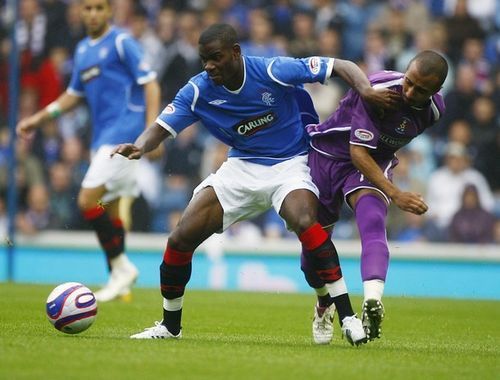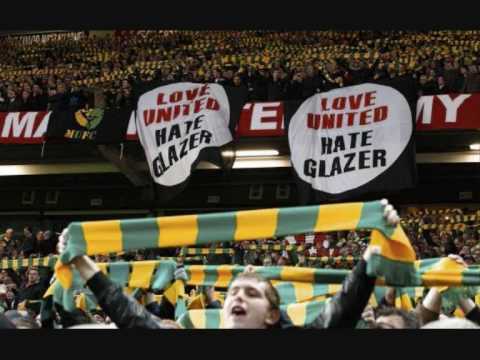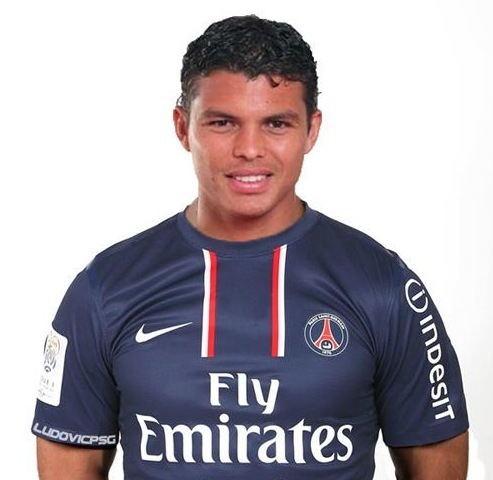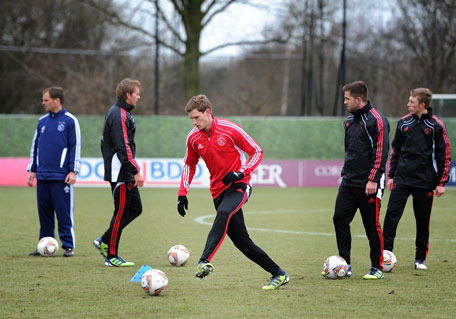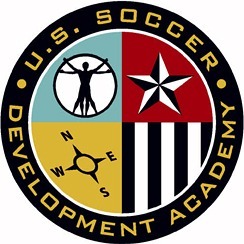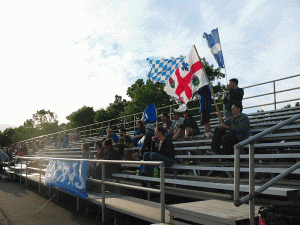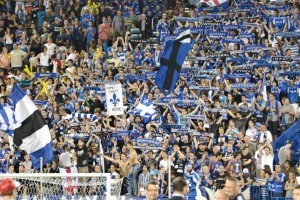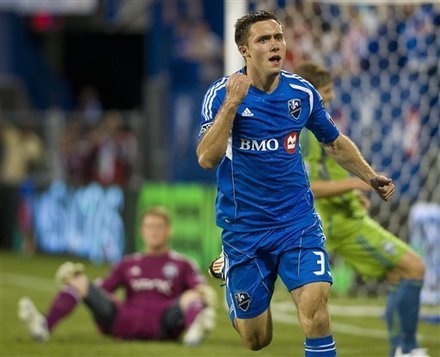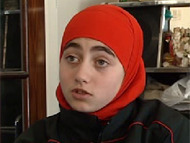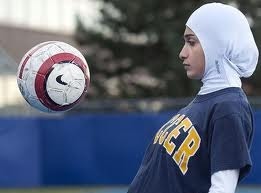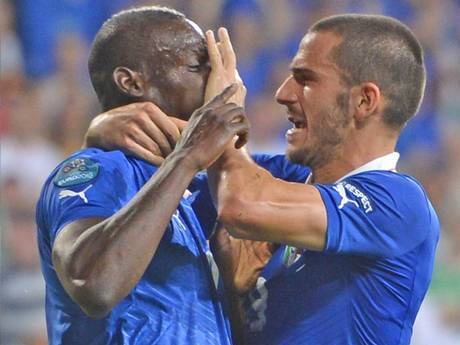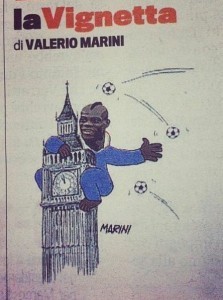Laurent Dubois's Blog, page 100
August 12, 2012
What is Soccer’s Business?
The business of a soccer club is to produce a winning team. At the end of the day sports are a form of entertainment. Too often, though, actions taken place in the board room or at the negotiating table take away from the entertainment displayed on the field. At times, the aggressiveness and sometimes greediness of clubs leads to failure on the field. Specifically, the mountains of debt some European clubs have amassed in recent years often do more harm than good for a club. Last year, players in La Liga — one of the world’s richest leagues — nearly went on strike when one club failed to pay wages. Earlier this year, Rangers FC entered administration after they could not pay some $77 million the club owed in taxes. I visited Rangers when I was younger on a European tour and since that time have considered it one of the oldest and most notorious club in Europe. The same has happened to F.C. Portsmouth for the second time in as many years. In both cases, the financial problems were the result of poor management decisions. When clubs with such great histories are suffering in this way, we have to ask ourselves whether there are fundamental problems with the way the business of soccer is being managed in many places.
In 2005, Malcom Glazer used the financial tool of a leveraged buyout (LBO) to purchase Manchester United for $1.5 billion and make the company private. In the end, I would argue, this action ultimately hampered the team’s ability to keep or purchase new star players. A leveraged buyout is where the takeover artist will borrow the majority of the cost to purchase the new company against the company’s future cash flows and current assets. More often than not in a LBO the new owners will have to sell key parts of the new business to pay down the debt. In the case of a soccer club their assets are their stadium and training grounds as well as their players. Manchester United, for instance, sold Cristiano Ronaldo to Real Madrid for a record transfer fee of $132 million. Even with the sale of Ronaldo, United has been unable to manage their mountainous debt payments and recently reissued shares of the club on the New York Stock Exchange for public purchase. Glazer raised $300 million dollars in the IPO, half will be used to pay down the $663 million in remaining debt. NYT blogger Graham Ruthven claims Sir Alex Ferguson may even benefit financially from the IPO. The IPO took place on Friday August 10th, with a $14 price. A price that was significantly supported by the underwriters of the IPO throughout the day. But what if the $800 million spent on interest payments and banking fees could have instead been spent on increasing the player and fan experience at Manchester United? Even with the new issuance, control of the club will be retained by the Glazer family as they will retain 67% of B shares which have voting power, so little will likely change in the general approach taken to the finances of the club.
As you can see from the photograph below, the actions by Glazer have outraged many fans of Manchester United, who consider that he has in some ways taken the club from them. They have a point. After all, as a “brand” a club is not only made up of it’s players and managers, but also of the fans and the tradition they carry with them.
Another instance of over spending and debt damaging a club is Leeds United, formally of the Premier League. Rather than piling on debt through a LBO , the club borrowed to purchase players. Leeds were a big club in the 1980s and 1990s, culminating in a Champions League semi-final place in 2001. But the club was ultimately undone by their Chairman Peter Ridsdale’s idea to go for it. He proceeded to use shady financial products to purchase players with borrowed money using future ticket sales as collateral. Essentially the fans loyalty. Ultimately it failed and the club had to sell assets at a blistering pace as the club entered administration: the stadium Elland Road (pictured below), training ground at Thorp Arch, and any player that was worth a nickel, including some considered to be part of England’s golden generation. Great players were sold at a severe discount due to the team’s financial troubles. The club also suffered demotion to England’s third tier and have since had to claw themselves back from the brink of extinction.
The idea of corporate borrowing is nothing new. Most companies must borrow to fund future growth. But there is a line between intelligent borrowing and getting caught in a credit crunch. Just like the many U.S. home owners who over-extended themselves between 2003 and 2008, soccer clubs may soon find themselves unable to pay their debts. In Europe, several countries — Spain, Greece, Ireland, Portugal and Italy — are desperately trying to reorganize its debt in order to make payments. Fiorentino Perez, the Chairman of Real Madrid and creator of the “Galacticos” is in the midst of de-leveraging in his real business, A.C.S., or Actividades de Construcción y Servicios. The company is one of the largest building services companies in the world. As he has done with Real Madrid, Perez has orchestrated huge loans, creating $12 billion in debt that the company has since had to sell assets to cover. Real Madrid, meanwhile, is currently $500 million in debt because of the money it has spent creating the “Galacticos” (pictured below). Many in business have believed that borrowing to fund instant success is the winning formula.But the formula only works as long as growth outpaces debt obligations.
The authors of the book “Soccernomics,” Simon Kuper and Stefan Szymanski, make a compelling argument that the outlandish transfer costs that have become the norm in professional soccer are not the way to success. “We studied the spending of forty English clubs between 1978 and 1997, and found that their outlay on transfers explained only 16 percent of their total variation in league position. By contrast, their spending on salaries explained a massive 92 percent of the variation” (48). They conclude that the market for player wages is efficient while the transfer market is well not efficient. You can see this inefficiency at work in many cases. Tottenham Hotspurs, for instance, transferred Jermaine Defore to Portsmouth and Robbie Keane to Liverpool for a combined $52 million only to bring them back a year later under new manager Harry Redknapp. Soccernomics provides the ultimate example of transfer market inefficiency. “In 1983 AC Milan spotted a talented young black forward playing for Watford. The word is that the player Milan liked was John Barnes, and that it then confused him with his fellow black teammate Luther Blisett.” Milan bought Blisett. This type of almost comical folly may be why, down the road, Milan has had to sell two of their most valuable players this summer to pay down debt — Zlatan Ibrahimovic and Thiago Silva (below), both to now super-wealthy club Paris Saint-Germain. AC Milan has run a total deficit of 245.4 million euros in the last 5 years. The spending of some of the biggest football clubs in the world is out of control.
Many clubs feel that they must take on such debt to keep up with the “Jones’s” — clubs like Manchester City and Chelsea, whose billionaire owners are not worried about the bottom line of the clubs they own. Sheik Mansour from Qatar bought Man City for a measly $330 million but then proceeded to spend close to double that on stocking his team with talented players. He was only following the lead of Chelsea owner Roman Abramovich (pictured below). UEFA reported that more than a quarter of the 650 soccer teams in Europe are spending $16.50 for every $13.50 of revenue. Running a deficit is fine for the super rich owners who care about nothing else than winning. Unfortunately not every team is owned by an owner with bottomless pockets. The massive television contracts in Europe are giving clubs increasing revenue. In June 2012 the English Premier League signed a record $4.7 billion/3 year television deal and the German Bundesliga signed a $3.2 billion/4 year deal. The deals were a 72% and 52% increase over the previous deals respectively. Compare those numbers with the $115 million Rupert Murdoch’s News Corp. paid for the television rights to the Premier League in 1992. But even with the rising revenue teams are still forced to borrow to compete with the billionaire owners of the world. European teams currently run a collective $1.5 billion deficit.
Some are trying to stop the process. Michel Platini (pictured below) has launched the Financial Fair Play (FFP) plan, which is meant to force European clubs to balance their books by the 2013/14 season. If clubs fail to balance their books they will be excluded from UEFA competitions.But what if Real Madrid, Inter Milan, Manchester United, Chelsea, Barcelona, Bayern Munich, Manchester City refuse to follow the rule and are kicked out of the Champions League. Mr. Platini, what happens then? Riddle me that?
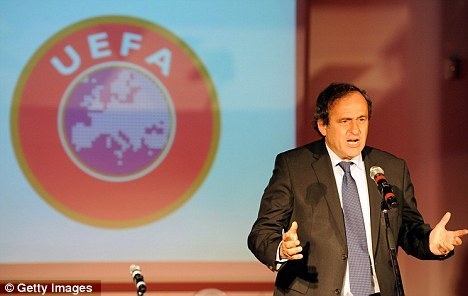
Perhaps clubs will have to start running teams like my namesake, Arsene Wenger. Are we related? I guess we will never know. He is a fantastic manager though. It is said Wenger uses statistics to judge a players future output on the field compared rather than over-evaluating a player’s past performances. He has a degree in Economic Sciences from the University of Strasburg in France: from an economic perspective, this player evaluation model makes much more sense than the approach taken by other clubs. It is similar to judging a blue chip stock. You don’t make your decision to invest on the stock’s previous performance but attempt to judge its future performance by looking at the fundamentals of the company presented in their financial reports. As players, our statistics are our financial reports.
Perhaps the Financial Fair Play plan will alter a shift in professional soccer in Europe. Barbara Berlusconi has underlined the need for change: “Soccer teams will have to transform into proper companies. If you can only spend what you get, then you have to keep costs in check and increase revenue. It’s a challenge that can become an opportunity.” This change in soccer will be a positive one if it improves what is produced on the field, or simply forces owners to be smarter with how they spend their money. The thing is soccer clubs are not like regular companies. The authors of Soccernomics say it best: “The business of soccer is soccer,” they note, and clubs “are more like musems: public-spirited organizations that aim to serve the community while remaining reasonably solvent.” The irony of what is happening today in so many clubs is that running a soccer club with pressure to make money may ultimately contradict its stated goal of winning on the field!
August 3, 2012
The Hijab on the Pitch
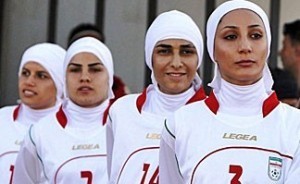
Members of the Iranian National Women’s Football team (Source: FIFPro)
On Friday, July 6, the French Football Federation announced that it would ban the wearing of hijab during all organized competitions held in France. The Federation declared that in doing so it was fulfilling its “duty to respect the constitutional and legislative principles of secularism that prevails in our country and features in its statutes.”
The decision came one day after the International Football Association Board — the body within FIFA that governs the laws of the game — unanimously declared that it would, for a “trial period,” allow players to wear the hijab during international competitions. France, then, is seeking to carve out an exception to an international ruling, one that links its football regulations to a broad set of laws that ban veils in public schools and public administration, as well as banning the burqa in all public spaces.
(The hijab covers the hair and neck; generally the term “veils” is used to describe coverings that also cover part of the face, though the usage varies quite a bit; and a burqacovers the entire face).
Scholars including Joan Scott and John Bowen have analyzed the history of these broader debates in rich detail, tying them both to longer colonial histories and contemporary battles over secularism, Islam, and immigration in France. The banning of the hijab from the football pitch was initially a relatively minor subplot in these broader battles over veils, hijab, and burqas in Europe and Canada. But the involvement of FIFA, the Iranian government, a Jordanian Prince, and the United Nations have helped to transform the terrain of football into an increasingly important battleground over the hijab.
The recent controversies are part of a longer, complex story of the presence of Muslim women in football, a topic nicely examined by Risa Isard on the Soccer Politics blog. But their more immediate background goes back to 2007. In that year, in Quebec, a referee at Under-12 girls’ soccer tournament ordered an 11-year-old player named Asmahan Mansour (pictured below) to remove the hijab she was wearing during play. She refused, and was told she would have to leave the field. As Mansour later explained: “I think it’s pathetic, really, ’cause it’s [the head scarf] tucked in my shirt.”
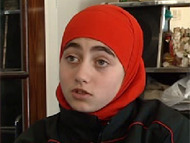
Asmahan Mansour (Source: Canadian Broadcasting Corporation)
In a powerful — but since little-reported — show of solidarity, her entire team along with four others playing in the tournament protested, refusing to continue playing unless Mansour was allowed to play. Their instant reaction to the decision speaks volumes. To them, it seems, Mansour’s hijab was a normal and unproblematic part of their daily lives as players, and the insistence that she remove it seemed an intolerable intervention — one they were so insulted by that they preferred to forfeit than to accept it.
Part of the reason for the strong reaction the girls had to the referee’s intervention is that Quebec’s position was at odds with that of other regions of Canada. In Ontario, for instance — and in Ottawa, where Mansour was from — officials and referees had allowed girls to wear the hijab as long as it was properly tucked into clothing so as not to present a hazard on the field. But the intervention on the football pitch was part of a broader pattern in Quebec, which like France has banned the burqa in all public spaces.
Mansour’s case was referred to the International Football Association Board (IFAB) in March 2007. They agreed with the decision of the referee, saying that Law 4 of the Rules of the Game listed the articles players could wear, and did not include headscarves. “If you play football there’s a set of laws and rules, and law four outlines the basic equipment,” said one IFAB member. “It’s absolutely right to be sensitive to people’s thoughts and philosophies, but equally there has to be a set of laws that are adhered to, and we favour law four being adhered to.”
The IFAB decision was, perhaps intentionally, vague: no mention was made of safety, the banning of religious or political symbols, or other reasons to prevent women from wearing a hijab. The conclusion was just that the current laws didn’t allow them to do so. In an interview, legal scholar Linda Sheryl Greene explores the potential implications of the decision. What became clear over time was that it was a precedent-setting decision in the world of football. Though national federations still had leeway about how they dealt with the issue in local competitions, the FIFA decision had a necessary trickle-down effect: federations couldn’t place players who insisted on wearing the hijab in teams in international competition.
As importantly, FIFA became the first global international organization to officially take up the issue of the hijab as a human rights issue. (The European Union Court had, on previous occasions, upheld the banning of hijab in both France and Turkey, rebuffing legal activists who claimed they were violations of human rights; but these decisions are territorially limited.) As a result, FIFA’s decision took on a kind of symbolic importance that the members of the organization had perhaps not, at first, expected it would.
The 2007 decision didn’t provide much guidance for subsequent attempts to justify the decision. After all, IFAB can change the Laws of the Game, as they have done on frequent occasions: so why not change them to allow hijab? In response to questions and pressure about the decision, however, FIFA and national federations offered a variety of justifications for the ban. One of the most frequent has been to insist that hijabs pose a safety hazard — that they could get caught during play, for instance, and perhaps strangle a player. This particular argument has always seemed like it would collapse under the weight of its own absurdity. After all, long hair is more likely to get pulled or tangled in play. And one could ask: if wearing something that covers your head poses a danger to players, why are goal-keepers allowed to do so according to Law 4, as Petr Cech famously does to protect his skull in the wake of an injury received on the pitch? The safety argument was probably deployed because it seemed the least controversial, a way to skirt the obvious cultural and religious struggles at work in this debate. The problem for those who wanted to use it to stop the approval of the hijab is that it was also relatively easy to confront: all that was needed was to develop a hijab that was relatively tight and attached with velcro (the way Cech’s headgear is) to avoid the danger of it being stuck around a player’s neck.
Another problem for FIFA is that there has, at least to my knowledge, never been any concern expressed by players themselves about the hijab. Indeed, like the girls in Quebec who walked off the field in 2007, many players have supported the rights of teammates to play while wearing one. The global player’s organization FIFPro came out in support of lifting the ban on veils, for instance. The organization Right2Wear has been advocating at the grassroots for women’s right to wear headscarves while playing football.
Such organizations on their own, however, probably would not have had the clout to reverse FIFA’s decision. Unlike France, Quebec, or Europe more broadly — where the bans on veils and burqas have been contested but never successfully overturned—FIFA has to deal with powerful internal constituencies who opposed their ruling on the hijab. For football federations from North Africa, the Middle East, and Asia seeking to develop the women’s game, the ban on the hijab represented a serious obstacle. Given the increasingly important role played by the region within FIFA, the association began as an ideal site for international political pressure against the ban.
The process of reversing the ban began in 2011, when FIFA officials stopped the Iranian national women’s team from playing in an Olympic qualifying game because their players were wearing hijab. The team was literally minutes from entering the field when they were told they could not play, though FIFA later claimed that the Iranian federation had been warned in advance they would not be allowed to play. Interestingly, during that incident FIFA justified the ban on hijab on the basis of regulations that outlaw the presence of “politics or religion” on uniforms, not based on the safety dangers cited in 2007. Iranian President Mahmoud Ahmadinejad attacked FIFA, referring to them as “dictators” and “colonialists,” while the Iranian ambassador to Jordan referred to the leaders of the international footballing organization as “extremists.”
As FIFA cynics pointed out at the time, the organization was perhaps the only one in the world capable of making Ahmadinejad sympathetic to a broader global consituency — especially on the issue of women’s rights. If Iran had been on its own in confronting FIFA, they might not have made much headway. But others also began mobilizing to criticize the ban. Jordan’s Prince Ali Bin Al Hussein took up the cause, and in March 2012 insisted that FIFA should overturn the ban. He argued that this decision was vital “to ensure that all women are able to play football at all levels without any barriers or discrimination.” (Jordan’s national women’s team had been forced not to select certain players for international competition because they wished to wear the hijab when they were playing.) And a United Nations sports advisor wrote to FIFA also urging them to lift the ban, arguing that “FIFA has the responsibility to ensure that everyone has an equal chance to participate in football.”
In March of this past year, FIFA voted to end the ban and allow players on the pitch in new, specially-designed, velcro-fastened hijab. Besides spurring on the creation of a whole new branch of athletic wear — one can imagining smiling Nike and Adidas executives reading the news — this was a significant reversal.
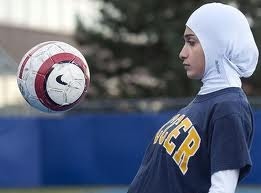
(Source: The Muslim Times)
It was, however, still tentative, for the issue of the safety of the hijab was still to be taken up by medical specialists at FIFA. Finally, on July 5, a full — if still temporary — approval of the hijab in international women’s play was passed by FIFA, prompting much celebration in some quarters, and the immediate refusal of the principle by the French Football Federation.
There will, undoubtedly, be more twists and turns to this issue. Globally, the hijab has become a crossroads for political and religious conflict, and it should come as no surprise that this is true in football, too. Yet there is something fascinating about this struggle over the right to play football in a hijab because of the nub of contradictions at work. Though they often used the pretext of player safety, what underlies the decisions of authorities who have banned the hijab is the idea that they were simultaneously protecting women from the veil and protecting the turf from expressions of worn Islamic religious identification. Those who have insisted that women and girls be allowed to play wearing the hijab have argued that to deny them this right is an attack against their freedom and equality. For the moment, the latter argument has — at least tentatively — won the day. This means that girls and women will no longer be asked to make a choice between the hijab and playing the game they love.
In the long-running debates over the banning of veils from French public schools, a minority of critics have persistently insisted on the fundamentally contradictory nature of such regulations. If the goal is to encourage the emancipation of women from patriarchal structures, how is excluding them from school the answer? And sociologists who interviewed the girls who were wearing veils to school in the 1980s and early 1990s found that their motivations, as well as their religious convictions, were extremely diverse and more often expressions of cultural or community pride — or a mechanism to avoid unwanted attention from boys — than the result of pressure from families.
Wearing a hijab onto the football pitch is an inherently complicated act. It is difficult to argue that, in doing so, girls and women are demonstrating deep submission to patriarchal gender constructions, for in the very act of participating in an intense, competitive, and highly public athletic contest they are pushing the boundaries of such constructions. From the beginning, the worry about the implications of wearing a hijab on the pitch has come from referees, national federations, and FIFA authorities, rather than from players. Many of them — like 11-year-old Mansour in 2007 — seem to feel none of the conflict or contradictions that those supervising their play feel about the garment.
Shireen Ahmen has recently written about the experience of playing in a hijab, describing with a mix of humor and irritation the constant questions she gets about doing so. Her piece asks readers to simply understand that wearing a hijab is “how I play. How I CHOOSE to play.” To those who ask her questions on the pitch — “Isn’t it hot?” — she offers: “I am not averse to answering questions. Just not in the middle of a match. Ask me after. I am happy to provide my number, a dinner invitation and a Tariq Ramadan website.” And though she imagines “scoring 3 goals and performing in some Messi-like manner whereby achieving a great victory for all oppressed Muslim women and earning the respect and acceptance of these nimrods,” in fact — just like any player — the reality is more banal. “Some games I play well. Some games I get called for illegal slide-tackles.” Ahmen’s piece offers precisely what we need more of now: an understanding of the lives of “hijabi footballers” as she calls them, that gets us back to reality on the pitch of play — and the play of individuality and community that is ultimately what football is about.
The official debate about the hijab in football is clearly far from over. Authorities in Quebec seem committed to pushing back against FIFA’s new rules, and have curiously brought the story full circle: just days after the ruling, they banned Rayane Benatti, a 9-year-old girl, from playing in a youth match in a hijab. They explained that they would wait until the International Football Association Board determined precisely what type of hijab could be worn (a decision they will take in October) before allowing any girls to play wearing them. But France and Quebec will likely be increasingly isolated in this stance; indeed, the Montreal Gazette itself published a strong editorial attacking the regional football association’s action.
Now that the hijab has been allowed back on the pitch by FIFA, perhaps football can help to confront and unwind the simplistic debates that have surrounded the issue for too long. After all, the day may not be too long off when a player in a hijab scores the winning goal for a country — maybe even England or Germany — in the Olympics or the World Cup, producing an image of triumph and belonging that can serve to trouble the other images of women veiled that govern and shape much debate in Europe on this topic. To allow the hijab on the pitch is to allow football to do the work that it can, at its best, do so well: confusing certainties, upending easy affiliations, and reminding us that no one has a monopoly on the future.
July 30, 2012
Youth Soccer
A football club cannot be successful without cultivating new young talent to supplement older veterans. This changeover is essential to continue moving forward. Clubs all over the world pay particular attention to developing their future stars for many reasons. If a club nurtures its younger players with the correct support and coaching the result will likely be a successful record on the field along with a healthy balance sheet. The prime examples are FC Barcelona and AFC Ajax, where the core of each team has emerged from the depths of their youth programs at La Masia and De Toekomst respectively. The Ajax youth academy is also prized for having filled the Dutch National team for years, and instilling the approach of “Total Football” in players.
Each has different styles to rearing football prodigies, but the goal is the same, to produce players to play for the first team. Ajax looks at their young players as a business investment, giving them everything they need to succeed and pays particular attention to not wearing their young athletes out for fear of losing their capital. And they certainly should for they routinely sell players they have trained in their academy for millions of euros. Their academy stresses that development and technique is the key to success. Rarely are wins and losses considered when determining which players will make it to the next level at such a young age.
Barcelona begins enrolling players in their academy (pictured above) at age 7, and they follow a rigorous schedule with little time for unsanctioned activities from dawn until dusk. While Spain and the Netherlands let the football tutelage specifically up to the clubs, France also employs a national training center in addition to club academies. These approaches are time proven to produce world class footballers that save their parent club’s millions in transfer fees. They have a structured plan to develop players and give them all the tools necessary to achieve. The question is, however, whether they give them the ability to live a normal childhood. People will argue that great players were never normal but what about the children who won’t earn World Footballer of the year? One of the costs of the academy system is that the single-minded focus on athletic training can leave players who ultimately don’t make it in the professional world without alternative skills or professional options.
For aspiring soccer players in the United States there is no real equivalent to these structured environments. Athletes are largely left to their own devices to figure out how to succeed. That is what I experienced growing up in Pennsyvlania.
I began my playing career like most young American children — in youth soccer. Seriously, is there a handbook somewhere that instructs all parents to enroll their children in youth soccer? It seems like almost everyone played on one soccer team or another during their childhood. But most won’t remember the team’s name — or the rules of the game for that matter. I, however, found a love for the game and progressed from one local youth select team to the next. First it was a county team, then a regional team, and then my local club team, Leeds United — which later became Pennsylvania Classics.

This is where Zarek and I began playing together at age 11. Although we played many games, it’s not clear to me now how many of them were truly worthwhile. We did a lot of traveling with Pennsylvania Classics and other select teams simply to get more practice and more exposure. I also competed for my high school team for three months of the year. That was a great social experience, but it disrupted my practice schedule with my club team. The other select teams were often apart of the U.S. Youth Soccer Olympic Development Program. In trying to progress towards the highest levels of the game, we tried to balance playing for these different teams as well as Pennsylvania Classics, but it wasn’t always easy.
Among players, everyone’s goal was to be asked to join the U.S. U-17 Men’s national team residency program in Bradenton, Florida. That program was the only place were you could get a high level of training on a daily basis. The program was modeled after the French Football Federation’s National Institute of Football at Clairefontaine. You could be scouted for U.S. U-17 team with Pennsylvania Classics at any of the number of tournaments we played in or on any of the various Olympic Development Teams. There was no clear path to attain the ultimate goal so we tried to do it all.
U.S. Soccer finally figured out that players, myself included, were playing way to many games with little meaning. So, they created the U.S. Soccer Development Academy Program; a league that has 78 clubs in the U.S. and Canada and culminates each year with a National Championship game. The “Development Academy” lays out a structured format for all elite players to compete against each other. It also has a set of guidelines for coaching instruction and puts an emphasis on development over winning games. Players are asked to forgo their other commitments, specifically high school soccer. This eliminates the need to play for multiple teams and allows them to concentrate on one avenue for success. At the same time, as Kyle Martino has noted, while high school soccer may disrupt club practices, it does provide an important avenue for social growth. The question is how to balance a pursuit of a professional dream and a normal childhood. Is it even possible?
My team later joined the development academy and saw a marked improvement in the competition. The Montreal Impact Academy is going to field two teams to join this very league in the coming year in the U-15/16 division and U-17/18. Outside of the MLS clubs with youth teams in the “Development Academy,” there is no direct path for youth players to take to a professional team.
Many MLS clubs are giving their youth players the support and coaching they need but most importantly a clear path to the first team. Youth players can achieve their goal by being offered a Homegrown Contract which allows them to sign for the MLS team without entering the draft. Andrew Lewellmen argues that Homegrown Contracts are the future of MLS as the league looks to capitalize on its investment in youth systems. The Montreal Impact have a very defined youth academy and have already shown that they are willing to sign deserving players to homegrown contracts. Our first team often plays the academy team; this gives them an opportunity to see the level they must attain. The Impact have stated that they modeled their academy off of the famed youth systems in France, Spain and the Netherlands mentioned above but curtailed it to specifically support the Quebec soccer community. It is set up with soccer schools, U-12 and U-14 teams that compete in the Quebec soccer league. U-16 and U-18 teams that will compete in the U.S. Soccer Development Academy and the U-21 team that will compete in the Canadian Soccer League. Karl Ouimette is a prime example of progressing through the academy as he is the first Montreal Impact player to be signed to a homegrown contract. Karl signed on June 5th 2012 and he commented that, “Being the first homegrown player is an honor and it is due to all the hard work I did with the academy. It also proves that the academy program trains players to be able to play with the first team.” He has certainly proven that the academy is a strong component of any successful club and specifically the Impact.
The club draws players from other Quebec clubs that have close to 85,000 players. The academy has a full time staff that is focused solely on coaching soccer players. Players in the Montreal Academy system have an advantage because they are seen on a regular basis by the coaches and administration of the first team. This would hopefully lead to a professional contract similar to Karl’s. Montreal is not the only MLS team with a youth system, every other club has an academy in some form or another. Most recently Toronto FC just unveiled their new academy structure that is looking to compete with the NCAA. In contrast I went to college at Duke University and eventually entered the MLS draft. Things may have been different had I had the opportunity to play for an MLS academy team before college. I certainly would have benefited from competing against better players. Though I do agree with Alexi Lalas, I feel that I was able to mature and grow as a person in college and learned to handle myself for the x number of hours that I was not on the field. I also grew considerably as a player. Could I have grown more if I had played in a less restrictive NCAA regulated environment where a prolonged season replicated a professional season? Possibly, but I will never know. I enjoyed my time in college and think it was a beneficial experience for me, not to mention I value my education. Is college for everyone, clearly not. Each player must figure out what is best for them.
There is no right way to accomplish your dreams but it is hard to argue that MLS academy systems and most European academies are giving players the tools necessary to succeed. What you will see is a movement to the MLS academy system and more and more players will be produced from the academies. The question is are all of these academies the correct balance of soccer and life at such a young age? At the end of the day there is no right answer for everyone, each individual is different and will take a different route to achieve their goals. Talent will always be recognized one way or another.
July 16, 2012
La Garde
Since my first game in Montréal — versus the Chicago Fire on March 17th 2012 — I have been struck and moved by the powerful support we get from our fans. It was my second game as a professional, so you might have thought I would have gotten over the nerves of playing in front of a large crowd. Only a week earlier, I had my debut as a second half sub versus the Vancouver Whitecaps. I’ll admit that at one point when play stopped for a throw in and substitution I took a few seconds to look up and marvel at the number of people in the crowd. Although we lost, after the game I realized how incredible it was to be playing in front of such a large group of spectators. When, a week later, I was substituted in against the Chicago Fire during the 2nd half, I ran out onto the field in front of 58,912 spectators, most of them our fans. As I pulled on my jersey I thought: “Try not to trip as you run onto the turf!” Though the game was a draw, it was truly magical to experience our fans and feel their support behind us the entire game.
It was incredible for close to 60,000 supporters to come out and show their support for the team and the organization. We felt their passion again during our recent game against Sporting Kansas City, when they clearly let their displeasure with the events on the field be known. It shows that they truly care about Impact de Montréal and the city.
One of the most moving shows of support came during the game against the Columbus Crew on July 8th. My roommate Zarek Valentin commented on twitter that the fans were unbelievable. We had suffered a few tough losses at that point in the season, and went down a goal in the middle of the second half. But no one left for the exits early. I was watching from the stands and saw only two men leave — but they returned two minutes later with fresh beers knowing it was going to be an exciting finish. Without the fans’ support we couldn’t have clawed back from the one goal deficit and eventually won the game. It was a special feeling those last 20 minutes as you could see the team recover mentally from the deficit and begin to earn the win as the excitement in the stadium got stronger and stronger. It was our fans that produced the collective feeling of belief and unity that helped the players on the field succeed. The fans truly were the 12th man, “La Garde.” They exuded a passion for the game and for our team that is typical of the city. All the players on the team are very thankful for the support for you have helped us through some tough times this year!
As I saw clearly from the reactions to my first post both here on the blog and on twitter, residents of Quebec and specifically Montréal really throw themselves into a cause or event they believe in. I have already commented that I was struck this year by the passion and effort the students of Montréal showed as they opposed laws they found unjust. It was a new experience for me moving from the States and seeing the scale of these protests. Though I don’t know enough about the details of the issue and am not endorsing or opposing their stand, I feel one must respect the commitment they showed to their cause, something that seems ingrained in the culture of the city. In my reading of “A People’s History of Quebec” I learned about the politics surrounding Bill 101 on August 26, 1977 — which parents of current university students must remember — which stipulated the use of French in government and other official capacities. At that time, residents in Montreal also stood up, supporting the culture and Bill they believed in. In the same way, this generation of students marched and stood for their beliefs.
Standing for what one believes in is clearly not a new idea to residents of Montréal, and it is something Impact de Montréal supporters group “les Ultras” do for 90 minutes — pun intended. Since I first saw their massive 60 foot banner and heard their support during my first home game in the Olympic stadium, I have been intrigued by our supporter groups les Ultras as well as 127 Montréal. I’m probably biased — and have yet to see the Sons of Ben, the Timbers Army, or the supporters of the Seattle Sounders in person, but the Impact ultras are one of the best supporters group in the MLS I have seen thus far in my short career.
I had a chance to chat with one of the members of the ultras, Eric Chenoix, about their organization which recently celebrated their ten year anniversary. I learned that the group began as an idea in 2001 when 60 Toronto Lynx fans invaded Claude-Robillard stadium unopposed. Group founders Daniel Nahmias Leonard and Patrice Vaillancourt made the idea a reality in 2002 when the small group encouraged the Impact to a 2-0 win over the Lynx. They set out to build a group whose sole mission is to support our team Impact de Montréal. Nick Sabetti recently covered the ultras’ anniversary with an article. He quoted Eric as describing the group as “apolitical” and saying, “We avoid mixing politics and football. We don’t even use the Québec flag, to avoid any association with separatism or anything like that, although we do use it on the road sometimes. We just want to support the Impact.” In my own conversation with Eric, I learned that the ultras took inspiration from the larger ultras movement in Europe, modeling themselves on groups in France, Belgium, and Germany but seeking to infuse the group with the traits of Montréal and its devotion to a cause. The term ultras is used for extreme football fans, and is meant to characterize their extreme devotion for their club and fellow members. I have been told that Ultras Montreal members see their support of the team as a job.
I have recently been reading two excellent books about “ultras” that help me understand a bit more about those I have encountered in the city. The first, about the fans of Millwall in England, was written by scholar Garry Robson named after one of their amusing chants: “No One Likes Us We Don’t Care!. The other is a recent account by journal Robert Andrew Powell of the supporters of a team in Cuidad Juarez, where soccer provides hope and community in the midst of violence.
The Indios de Ciudad Juarez are also loved by residents in Juarez, Mexico for whom it is one of the few positive aspects of their lives as drug cartel warfare rages on their doorstep. Powell’s book, which focuses on a group of fans who call themselves — with a bit of irony — “El Kartel,” gives a riveting depiction of not just soccer but also humanity in a modern day war-zone. It illustrates how the power of a soccer team’s promotion can allow its fans a brief respite from the horrors of everyday life. The fans of the Indios may live in an inhospitable place but they still find the need to support their team.
The Impact ultras, then, are part of a global cultural phenomenon that is a central part of what makes soccer such a powerful and meaningful sport for communities throughout the world.
Two hours before a game, the Ultras Montréal meet at Bar 99 on Hochelaga Street. From there, they walk as a group to the stadium where they take their positions in section 132. There they have some 20 different chants they use to invigorate the crowd in Stade Saputo in support of the players on the pitch. Since I have been injured recently, I often sit behind the ultras and I always enjoy the way the chant leader or capo directs to the group. There is one particular chant I love. I don’t know what it is called or what the words are, but everyone sits down for about 30 seconds and bangs their feet on the stands before finally jumping up and waving all their scarves and flags. I get a kick out of it every time.
Outside game days, the group meets regularly. They enjoy each others’ company, for they have a common bond in their support and passion for the Impact. They spend time making flags and tifos, watching away games or planning trips to those very games. Each member designs their own flags and tifos, which allows them to individually express their own form of support for the club and the greater city of Montreal. When I asked if the group drew on a specific demographic in the population, I was told that the only thing that united them all was a passion for the Impact. Otherwise it is quite a diverse group. To become a member of the ultras it is simple: fans just need to get involved in the group by coming to games and other group events, living their passion for club, and investing their time.
The ultras are not the only supporters’ group for our club. The fans in section 127 of Stade Saputo are known as 127 Montreal. Though their group’s inception was much more recent, their support is just as passionate. The group was reportedly founded — as most supporter’s groups all over the world probably are! — over several pints of beer in early 2011. Since then, it has flourished. Instead of a march to the match they can always be found in the parking lot before the game tailgating. I have often walked by on my way into the stadium and they are always having a good time getting themselves prepared for the match. All you have to do to join in is go up and introduce yourself and talk about the team.
From my brief experience in Quebec, it seems to me that here professional teams — whether the Habs or the Impact — in some ways take on the status of representing the province as a whole. Given the strong provincial pride, and the two relatively recent attempts at establishing Quebecois sovereignty, I’m curious about what the local relationship is to the Canadian national team. I know Patrice Bernier is a native of Montreal and has represented his country 46 times. But I wonder: do fans here have more admiration for, CNT of IMFC? Or do they support both equally, but in different ways? How deeply do political sentiments in favor sovereignty influence sports fandom? Like the Impact ultras, many fans prefer to see their relationship to a team as “apolitical,” and yet it seems that at times it’s difficult to untangle sport from regional or national political contexts.
I have profiled two of the Impact’s supporters groups here. But these groups do not make up the bulk of the fans of our club. Though what we might call “the common fan” does not align themselves with a certain group, their passion is just as strong. Perhaps we can start a conversation to find a way so that, once or twice during the game, all the fans can join together in one concerted effort to support the club and the city. This could take the form of a quick chant or simply raising your scarf above your ahead at the beginning of each half. It would be a great way to celebrate and enjoy the unity of all the fans in the stadium, who have a common affinity in supporting the team and loving Montreal.
As a player I am always working and searching for that one night when everything goes right. It rarely happens. But you keep searching for that mystical apex of perfection. The same goes for fans for you routinely come back to cheer on and support our team, thinking and hoping that tonight could be the special night when everything falls into place and works perfectly. Laurent Dubois comments in his book “Soccer Empire”: “Football games open up incredible spaces of mass mobilization, public fervor, and hope. They give spectators the rare feeling of being ‘exactly at the right place at the right time’ and ‘at the centre of the whole world’ writes Nick Hornby ‘” He also quotes the novelist B.S. Johnson, who writes about the felling that accompanies the beginning of any soccer game: “‘Always, at the start of each match, the excitement, often the only moment of excitement, that this might be the ONE match,’ . . . the one ‘where the extraordinary happens,’ the game ‘one remembers and talks about for years afterwards, the rest of one’s life.’”(21)
Let’s be honest — we may be searching for that night for a while. In the meantime, though, we can fill each night in the Stade Saputo with the collective belonging that celebrates Montreal and it’s culture. We can make each night one where everyone believes tonight is the tonight, doesn’t give up on our team even in the face of adversity and continues to stand and support us. Those are the nights when the hair rises on the back of your neck — for you know something special is happening and that this is a special place. Nights like that of July 8th 2012 against the Columbus Crew.
As always, I invite you to leave your thoughts, tell me where I am right or wrong, or simply suggest what I should look at next. Leave a comment here or tweet to @andrewwenger.
July 10, 2012
From Montréal with Love
2012 is a big year for Montréal sports and the Saputo Family. Following a 20 year existence the family-owned football club “Impact de Montréal” finally entered Major League Soccer. It is a year of firsts for our club, for it saw our first game, first goal, first win, and first game in the redeveloped Stade Saputo. I have had the pleasure of being apart of many of these firsts, actually scoring the winning goal and my first professional goal in our first MLS win versus our rivals Toronto FC on April 7th, 2012.
Being in Montréal I have begun to realize that the city has a culture that is unlike any other in North America. This culture plays a hand in the soccer and politics of this great city. Any newcomer to a Impact game will immediately realize that our supporters group, “les Ultras” sing and chant in French. This is just an introduction to the unique culture of our club and this great city.
The best place to start for an understanding of Quebec politics is to go through Quebec’s long history. Since arriving in Montréal, I’ve been reading A People’s History of Quebec in order to better understand the history of the city where I now play.(The quotes and page references below are from this book). I’ve learned that the roots of the territory’s current political issues are grounded in an event that happened centuries ago. On July 24, 1534, Jacques Cartier and his men erected a large cross with the three fleurs-de-lis on the Gaspe Peninsula and declared the territory for the King of France. Jacques Cartier then moved further up the St. Lawrence river and settled on Montréal Island for the winter effectively founding the city. Today Jacques Cartier is honored with a plaza donning his name in the Old Port of Montreal, which is a large tourist destination. Additionally the fleurs-de-lis is enshrined on the flag of Quebec and on our Montréal Impact jerseys. It is a national symbol of Quebec and one that is meant to invoke “the francophone character of the province.”
This strong French culture intensified as Montréal was settled by Paul de Chomedey de Maisonneuve in May 1642. Montreal soon became the main focus of France as it worked to colonize ‘New France.’ This decision laid the groundwork for a specific people with French culture in Quebec that was uniquely different from the rest of British controled territory in what is present day Canada. It was during this time that settlers in the St. Lawrence Valley began to identify themselves as different than their French counterparts in France and rather as “Canadiens.” During the 1660′s the newly minted “Canadiens,” “preferred to be called ‘habitants’ instead of ‘paysans’ or peasants as they were in France.” (24) This term is still used today and identifies Montréal’s hockey team as the ‘Montréal Canadiens’ and their popular nickname being “Les Habitants.”
What unsettled “Les habitants” was their capitulation to the British during the “Seven Years War” or what as Canadiens refer to it the “War of Conquest.” The differences between the French Canadiens (what Quebecers began calling themselves as English speakers adopted ‘Canadians’) and British cultures are immense specifically being the language and religion: Protestants and Catholics. These issues were only worsened as the British rulers attempted to assimilate French Canadiens into British culture. In 1766, for instance, “the Attorney General of the Province, Francis Maseres, held that the only way to eliminate the growing conflict between the French and English speakers was to simply assimilate those who spoke French.” (72) This statement led to resentment from French speakers as they clung to their language and specifically their religion.
Today Montréal is officially a French speaking city, all of the traffic signs and government documents are in French, and I can add from personal experience my lack of French has left me in awkward positions more than once. I often found it tough trying to figure out where I wanted to go (though my lack of a sense of direction may be the true cause of that.) Though many French Canadiens appreciate my poor attempts at “Bonjour, como ca va” it leaves me at a real disadvantage in truly understanding and assimilating into the culture. Learning the French language is an important way for me to endear myself to the fans, but I will be honest it is not an easy task.
French Canadiens have fought tooth and nail defending their unique culture and language in Montréal, which is distinct compared to the rest of Canada. The Act of Union officially made English the primary language of Quebec in the 1840s but Montréal and the rest of Quebec resisted and over time built up a harden and sometimes malicious defense. Following the Confederation of Canada in 1867 Montreal has worked to regain their sovereignty. They installed the Ministry of Culture during the Quiet Revolution, used physical force and intimidation at the hands of the FLQ (Front de Liberation du Quebec) before finally making French the official language in 1977. These efforts were followed by two unsuccessful attempts to affirm sovereignty referendums for Quebec. The latest one in 1995 lost by the slimmest of margins of 50.6% no to 49.4% yes. Residents of Montréal and the greater Quebec province take their allegiances and culture very seriously.
This immense passion for Quebec nationalism is also evident when fans support their favorite sports teams. The enthusiasm and love for the Montréal Canadiens is no joking matter in Montreal. The team’s performance directly affects the moods of thousands of Montréalers. Though fans of Impact de Montréal are a smaller group, they are equally ardent in their support of the club and the players. This type of passion is shown in times of glory and failure — let me tell you, our fans will let you know their feelings. That is fantastic, as it makes me yearn to please them and earn their admiration in return.
This post has been an introductory post to shed light on the back story of Montréal and its culture, a culture that is clearly apparent in its sports teams and their fans. It has been interesting for me to learn about the prominent names that helped shape this city’s rich history such as Rene Levesque, Papineau, Frontenac, Jean-Talon. Pierre Elliot Trudeau, Maisonneuve and Jacques Cartier. Their names now don many places in the city. If you want to learn more about Montreal’s history or are considering visiting the “Paris of North America” you can visit this website for additional historical knowledge or read “A People’s History of Quebec.” This post is the first in a series of articles I am going to be writing in the next few months that look at the politics and soccer in Montréal. If you have suggestions for article topics or comments on what I’ve written here I more than welcome them in the comments section or on twitter at @andrewwenger.
July 8, 2012
The Hijab on the Pitch
The decision came one day after the International Football Association Board — the body within FIFA that governs the laws of the game — unanimously declared that it would, for a “trial period” allow players to wear the hijab during international competitions. France, then, is seeking to carve out an exception to an international ruling, one that links it’s football regulations to a broad set of laws that ban veils in public schools and public administration, as well as banning the burqa in all public spaces. (The hijab covers the hair and neck; generally the term “veils” is used to describe coverings that also cover part of the face, though the usage varies quite a bit; and burqa covers the entire face).
Scholars including Joan Scott and John Bowen have analyzed the history of these broader debates in rich detail, tying them both to longer colonial histories and contemporary battles over the secularism, Islam, and immigration in France. The banning of the hijab from the football pitch was initially a relatively minor subplot in these broader battles over veils, hijab, and burqas in Europe and Canada. But the involvement of FIFA, the Iranian government, a Jordanian Prince and the United Nations have helped to transform the terrain of football into an increasingly important battleground over the hijab.
This week’s announcements are the latest twist that began in 2007. In that year, in Quebec, a referee at Under-12 girl’s soccer tournament ordered an 11-year-old player named Asmahan Mansour (pictured below) to remove the hijab she was wearing during play. She refused, and was told she would have to leave the field. As Mansour later explained simply: “I think it’s pathetic, really, ’cause it’s [the head scarf] tucked in my shirt.”
In a powerful — but since little-reported — show of solidarity, her entire team along with four others playing in the tournament protested, refusing to continue playing unless Mansour was allowed to play. Their instant reaction to the decision speaks volumes. To them, it seems, Mansour’s hijab was a normal and unproblematic part of their daily lives as players, and the insistence that she remove seemed it an intolerable intervention — one they were so insulted by that they preferred to forfeit than accept it.
Part of the reason for the strong reaction the girls had to the referee’s intervention is that Quebec’s position was at odds with that of other regions of Canada. In Ontario, for instance — and in Ottawa, where Mansour was from — officials and referees had allowed girls to wear the hijab as long as it was properly tucked into clothing so as not to present a hazard on the field. But the intervention on the football pitch was part of a broader pattern in Quebec, which like France has banned the burqa in all public spaces.
In the wake of the incident FIFA took up the question of whether the hijab should be allowed. They concluded that the referee in Quebec had been right: the hijab was pronounced a danger to the safety of players. To me, at least, this argument has always seemed like it would collapse under the weight of it’s own absurdity. After all, long hair is more likely to get pulled or tangled in play. And one could ask: if wearing something that covers your head poses a danger to players, then why is Petr Cech allowed wear one in every match (including international competition) — to protect his head? (Cech’s head-gear serves to protect his skull in the wake of an injury received during play, and obviously is not the same as a hijab in structure; the point is just that the idea that a head-covering is dangerous seems a hard to sustain). I would argue that the safety argument has, from the beginning, served largely as a pretext for the cultural struggles at work in this debate. It would never have been difficult to develop the sort of hijab that are now widely used, which attach closely to athletes heads to avoid the possibility they will get somehow get caught or pulled off during play in a dangerous way.
FIFA’s decision only applied to international competitions: national federations could make their own decision about the issue when it came to the competitions they oversaw. But since women who refused to play without a hijab were effectively banned from international competition, national federations effectively had to discriminate against such players in composing their highest-level teams. As significantly, with this ruling FIFA became the first global international organization to take up the question of the hijab. (The broader legal implications of this were explored nicely in this interview with legal scholar Linda Sheryl Greene.) The European Union Court had, on previous occasions, upheld the banning of hijab in both France and Turkey, rebuffing legal activists who claimed they were violations of human rights. But the United Nations had never, to my knowledge, taken up the issue. So FIFA’s decision took on a kind of symbolic importance that the members of the organization had perhaps not expected it would.
And in time, the fact that FIFA is truly global in scope is what ultimately led to the overturning of the 2007 decision. For especially given the increasing prominent of Middle Eastern countries, North Africa, and Asian countries with large Muslim populations within both global football and FIFA, the association began an ideal site for political pressure against the banning of hijab, which has never yet been successful in reversing such bans in Europe or Canada.
Like the girls in Quebec who walked off the field in 2007, many players have supported the rights of teammates to play with a hijab. Players throughout the Middle East have been doing so for decades in a variety of contexts. The global player’s organization FIFPro came out in support of lifting the ban on veils, for instance. The organization Right2Wear has been advocating at the grassroots for women’s right to wear headscarves while playing football. But such organizations on their own probably would not have had the clout to reverse FIFA’s decision.
In 2011, however, FIFA officials stopped the Iranian national women’s team from playing in an Olympic qualifying game because their players were wearing hijab. The team was literally minutes from entering the field when they were told they could not play, though FIFA later claimed that the Iranian federation had been warned in advance they would not be allowed to play. Interestingly, during that incident FIFA justified the ban on hijab on the basis of regulations that outlaw the presence of “politics or religion” on uniforms, not based on the safety dangers cited in 2007. Iranian President Mahmoud Ahmadinejad attacked FIFA, referring to them as “dictators” and “colonialists,” while the Iranian ambassador to Jordan referred to the leaders of the international footballing organization as “extremists.”
As FIFA cynics pointed out at the time, the organization was perhaps the only one in the world capable of making Ahmadinejad sympathetic to a broader global consituency — especially on the issue of women’s rights. If Iran had been on it’s own in confronting FIFA, they might not have made much headway. But many other countries began mobilizing to criticize the ban. Jordan’s Prince Ali Bin Al Hussein took up the cause, and in March 2012 insisted that FIFA should overturn the ban. (Jordan’s national women’s team had been forced not to select certain players for international competition because they wished to wear the hijab when they were playing.) And United Nations sports advisor wrote to FIFA also urging them to lift the ban, arguing that “FIFA has the responsibility to ensure that everyone has an equal chance to participate in football.”
In March of this past year, FIFA voted to end the ban and allow players on the pitch in new, specially-designed, velcro-fastened, hijab. Besides spurring on the creation of a whole new branch of athletic wear — one can imagining smiling Nike and Adidas executives reading the news — this was a significant reversal.
It was, however, still tentative, for the issue of the safety of the hijab was still to be taken up by medical specialists at FIFA. Finally, Thursday, a full — if still temporary — approval of the hijab in international women’s play has been passed by FIFA, prompting much celebration in some quarters, and the immediate refusal of the principle by the French Football Federation.
There will, undoubtedly, be more twists and turns to this issue. Globally, the hijab has become a crossroads for political and religious conflict, and it should come as no surprise that this is true in football too. Yet there is something fascinating about this struggle over the right to play football in a hijab because of the nub of contradictions at work here. The French and Quebecois authorities, and FIFA, who banned the hijab did so for various reasons: they sometimes evoked worries about safety, but underlying their decisions was the idea that they were in effect protecting women from the veil, or else protecting the turf from expressions of worn Islamic religious identification. Those who have insisted that women and girls be allowed to play wearing the hijab have argued that to deny them this right is an attack against their freedom and equality. For the moment, the latter argument has — at least tentatively — won the day. That is a victory for the many women and girls who will have renewed access to the field of play. Through their very presence in that space, they can help to confront and unwind the many misunderstandings surrounding the hijab. More importantly, they will be able to play the game they love.
The Veil on the Turf
On Friday, the French Football Federation announced that it would ban the wearing of veils during all organized competitions held in France. The Federation declared that in doing so it was fulfilling it’s “duty to respect the constitutional and legislative principles of secularism that prevails in our country and features in its statutes.” The decision came one day after the International Football Association Board — the body within FIFA that governs the laws of the game — unanimously declared that it would, for a “trial period” allow players to wear the veil during international competitions. France, then, is seeking to carve out an exception to an international ruling, one that seeks to make it’s football regulations consistent with a broad set of laws that ban veils in public schools and public administration, as well as banning the burqa in all public spaces. A similar law was also passed in Quebec. Scholars including Joan Scott and John Bowen have analyzed the history of these debates in rich detail, tying them both to longer colonial histories and contemporary battles over the secularism, Islam, and immigration in France.
The banning of the hijab from the football pitch was initially a relatively minor subplot in the broader political, and much longer, battles over veils in Europe and Canada. In 2007, in Quebec, a referee at Under-12 girl’s soccer tournament ordered an 11-year-old player named Asmahan Mansour (pictured below) to remove the hijab she was wearing during play. She refused, and was told she would have to leave the field.
In a powerful — and little-reported — show of solidarity, her entire team along with four others playing in the tournament protested, refusing to continue playing unless Mansour was allowed to play. Their instant reaction to the decision speaks volumes. To them, it seems, Mansour’s hijab was a totally normal and unproblematic part of their daily lives as players, and the insistence that she remove it an intolerable intervention — one they were so insulted by that they preferred to forfeit the chance to win in the tournament rather than accept it. Mansour’s response was simple: “I think it’s pathetic, really, ’cause it’s [the head scarf] tucked in my shirt.”
The incident in Quebec, however, created a problem that quickly found it’s way to the FIFA, which was asked to decide whether the hijab should be allowed. And the decision was made then that the referee in Quebec had been right: the hijab was pronounced a danger to the safety of players. This argument has, always, seemed like it would collapse under the weight of it’s own absurdity. After all, long hair is more likely to get pulled or tangled in play. And one could ask: if wearing something that covers your head poses a danger to players, then why is Petr Cech allowed wear one in every match (including international competition) — to protect his head? Cech’s head-gear serves to protect his skull in the wake of an injury received during play, and obviously is not the same as a hijab in structure; the point is just that the idea that a head-covering is dangerous seems a hard to sustain; the safety argument serves, it seems to me, largely as a pretext for the cultural struggles at work in this debate.
FIFA’s decision had to do with international competitions: national federations could make their own decision about the issue when it came to the competitions they oversaw. But of course women who refused to play without a hijab were effectively banned from international competition, which meant that national federations effectively had to discriminate against such players in composing their highest-level teams.
With this ruling, FIFA became the first global international organization to take up the question of the hijab and human rights. The European Union Court had, on previous occasions, upheld the banning of hijab in both France and Turkey, rebuffing legal activists who claimed they were violations of human rights. But the United Nations had never, to my knowledge, taken up the issue.
In time, the fact that FIFA is truly global in scope is what ultimately led to the overturning of the 2007 decision. For especially given the increasing prominent of Middle Eastern countries, North Africa, and Asian countries with large Muslim populations within both global football and FIFA, the association began an ideal site for political pressure against the banning of hijab, which has never yet been successful in reversing such bans in Europe or Canada. (The broader legal implications of this were explored nicely in this interview with legal scholar Linda Sheryl Greene.)
Like the girls in Quebec who walked off the field in 2007, many players have supported the rights of teammates to play with a hijab. The global player’s organization FIFPro came out in support of lifting the ban on veils, for instance. The organization Right2Wear has been advocating at the grassroots for women’s right to wear headscarves while playing football. But such organizations on their own probably would not have had the clout to reverse FIFA’s decision.
In 2011, FIFA officials stopped the Iranian national women’s team from playing in an Olympic qualifying game because their players were wearing hijab. The team was literally minutes from entering the field when they were told they could not play, though FIFA later claimed that the Iranian federation had been warned in advance they would not be allowed to play. Interestingly, during that incident FIFA justified the ban on hijab on the basis of regulations that outlaw the presence of “politics or religion” on uniforms, not based on the safety dangers cited in 2007. Iranian President Mahmoud Ahmadinejad attacked FIFA, referring to them as “dictators” and “colonialists,” while the Iranian ambassador to Jordan referred to the leaders of the international footballing organization as “extremists.”
As FIFA cynics pointed out at the time, the organization was perhaps the only one in the world capable of making Ahmadinejad sympathetic to a broader global consituency — especially on the issue of women’s rights. If Iran had been on it’s own in confronting FIFA, they might not have made much headway. But many other countries began mobilizing to criticize the ban. Jordan’s Prince Ali Bin Al Hussein took up the cause, and in March 2012 insisted that FIFA should overturn the ban. (Jordan’s national women’s team had been forced not to select certain players for international competition because they wished to wear the hijab when they were playing.) And United Nations sports advisor wrote to FIFA also urging them to lift the ban, arguing that “FIFA has the responsibility to ensure that everyone has an equal chance to participate in football.”
In March of this past year, FIFA voted to end the ban and allow players on the pitch in new, specially-designed, velcro-fastened, hijab. Besides spurring on the creation of a whole new branch of athletic wear — one can imagining smiling Nike and Adidas executives reading the news — this was a significant reversal.
It was, however, still tentative, for the issue of the safety of the hijab was still to be taken up by medical specialists at FIFA. Finally, Thursday, a full — if still temporary — approval of the hijab in international women’s play has been passed by FIFA, prompting much celebration in some quarters, and the immediate refusal of the principle by the French Football Federation.
There will, undoubtedly, be more twists and turns to this issue. Globally, the hijab has become a crossroads for political and religious conflict, and it should come as no surprise that this is true in football too. Yet there is something fascinating about this struggle over the right to play football in a hijab because of the nub of contradictions at work here. The French and Quebecois authorities, and FIFA, who banned the hijab did so for various reasons: they sometimes evoked worries about safety, but underlying their decisions was the idea that they were in effect protecting women from the veil, or else protecting the turf from expressions of worn Islamic religious identification. Those who have insisted that women and girls be allowed to play wearing the hijab have argued that to deny them this right is an attack against their freedom and equality. For the moment, the latter argument has — at least tentatively — won the day. That is a victory for the many women and girls who will have renewed access to the field of play. Through their very presence in that space, they can help to confront and unwind the many misunderstandings surrounding the hijab. More importantly, they will be able to play the game they love.
July 5, 2012
¡Tricampeones! Spain complete their cycle
“Years have gone by and I’ve finally learned to accept myself for who I am: a beggar for good football. I go about the world, hands outstretched, and in the stadiums I plead: ‘A pretty move, for the love of God.’ And when good football happens, I give thanks for the miracle and I don’t give a damn which team or country performs it.”
- Eduardo Galeano
They are calling them el generation de fenómenos – ‘the generation of phenomenons.’ On the night of July 1, 2012, in Kiev, the most talented generation of footballers that Spain has ever produced – or, perhaps, will ever produce – fashioned their most lucid performance. With their destruction of Italy by four goals to nil, the largest margin of victory in a European or World cup final, Spain has become the only team to defend successfully the European Championship, and the first international side since the Uruguay teams of 1924, 1928, and 1930 to win a hat-trick – tres tantos – of consecutive major tournaments.
Spain, the perennial underachievers have become perennial world-beaters and record-setters. Much has been made of the fact that the cycle that was set in motion when Spain defeated their bête noire, Italy, on penalties in 2008, a team that they had never previously beaten in tournament football, has now come full circle. Italy has been beaten again, and with panache.
Spain’s recent dominance of world football has been so staggering that we must rouse ourselves from the enchanted state that their mesmeric play is capable of inducing and remind ourselves of its unreal reality: Spain have not so much as conceded a goal in a knock-out game since Zinedine Zidane scored a break-away solo effort in their 2006 World Cup quarter-final against France. Or to put it another way, as Rob Smyth has observed, “Iker Casillas’s net has been untouched for sixteen and a half hours.” Spain’s extraordinary cycle has been defined not only by their inventive and artistic football, but also by their impregnability.
Yet, it is not for achieving their record-setting triptych of victories that Spain 2008–’10–’12 now assumes a place in the pantheon. Hungary 1953, Brazil 1970, Holland 1974, Brazil 1982: football’s immortal sides are not mere winning machines, but the workers of miracles. Last night, Spain’s miracle was to play at a level of such audacious incisiveness, married to an impregnability approaching perfection, that, as Pablo Neruda might have put it, it were as if the moon and the stars lived in the lining of their skin. If it was not quite as astounding as Barca’s 5–0 destruction of Real Madrid in 2010, the spectacle of the condemned Italians chasing Spanish moon-shadows was both exquisite and cruel.
That the Italians had sight of goal on occasion only exacerbated the cruelty of the joke: as if the cat-like Casillas would ever be beaten! Denied agency, Spain’s adversaries became mere victims: the harder Italy chased, bravely competing for territory and possession, the more stretched they became and the more hopeless their cause. By half-time Spain were two goals to the good.
Jonathan Wilson has argued that Pep Guardiola’s final season at Barcelona became like a Greek tragedy – the hero aware of his destiny yet unable to prevent it. This final’s narrative arc also took on something of the hue of Greek tragedy: Spain compelled Italy to chase the game, creating the conditions in which Italian defeat would be fulfilled by their desperate attempts to avert it. The theme of Italy’s defeat had been scripted through the ages: Aeschylus and Sophocles, Yeats, Mann, and Conrad. Italian defenders strained and stretched sinews, contorted their bodies (to breaking point in the cases of Giogio Chiellini and Thiago Motta), pressed and continued to chase, but Spain’s prodigies created or discovered space where none seemed to exist, stretching, manipulating, and piercing defensive lines, seemingly at will. Such exquisite mastery sears itself in the memories of aficionados forever.
The aesthetic aspect of Spain’s sublime technique and dazzling collectivity is consummate evidence with which to buttress Lilian Thuram’s contention: “Footballers can be like artists when the mind and body are working as one. It is what Miles Davis does when he plays free jazz – everything pulls together into one intense moment that is beautiful.”
Intense moments of beauty in which fantasy and reality blur: Xavi’s perfectly measured pass for Jordi Alba in full-flight, inviting the left-back to return to earth to score a goal I had only thought possible on a Playstation; the balletic quality of an Iniesta body-swerve; the high-speed smuggling of the ball through, between, around, and away from Italians all night long; the sublime improvisation inherent to what Xavi calls “mig-toc” – “half-touch” – tiki-taka that maps the coordinates of a beautiful and unrelenting dance: ‘there is only one ball and you shall not have it.’
With Spain’s near flawless performance in Kiev, the argument about the identity of football’s greatest team just got more complicated.
June 26, 2012
Mario Balotelli and the New Europe
During international football competitions like the European Cup, eleven players briefly become their country, for a time, on the pitch. A nation is a difficult thing to grasp: unpalpable, mythic, flighty. Historians might labor away to define the precise contours of a country’s culture and institutions, and even sometimes attempt to delineate it’s soul, while political leaders try mightily (and persistently fail) to stand as representatives of it’s ideals. But in a way there is nothing quite so tactile, so real, as the way a team represents a nation: during their time on the pitch, they have in their hands a small sliver of the country’s destiny. And in those miraculous and memorable moments when individual trajectories intersect with a national sporting victory, sometimes biographies and histories seem briefly to meld. At such moments, the players who inhabit the crossroads of sporting and national history –Maradona in 1986, Zidane in 1998 — become icons, even saints.
This charged atmosphere can also mean that the collective of a given country’s team can also become a symbol. This was perhaps most forcefully the case in France in 1998, when the fact that the country had won it’s first World Cup with a team bewildering in it’s jovial diversity (Armenian! Algerian! Guadeloupean! Kanak!) was taken by many as signifying and symbolizing the arrival of a new France. The feeling was short-lived but powerful, indeed energizing. And it suggested one particularly powerful way through which international football competitions can speak to questions about national identity and belonging, and more specifically the place of immigration and immigrants in the nation.
Watching the 2012 European Cup competition, you can increasingly see how histories of immigration have reshaped the world of European football. For a long time, France was relatively unique in the extent to which players with roots outside of Europe played central roles on the national football squad. It’s a tradition that goes back to the early 20th century in France — in the 1930s the Senegalese player Raoul Diagne and the Moroccan Larbi Ben Barek both played on the French national team, for instance, and a string of Algerian players did as early as the 1920s and through the 1950s. Portugal, meanwhile, had the great Mozambican-born Eusebio in the 1960s. The great French generation of Michel Platini, in the late 1970s and early 1980s, included a number of players with African and Caribbean roots. By then, other countries — particularly the Netherlands, which famously included several players of Surinamese background, and England which in the late 1970s incorporated a series of black players largely of Caribbean ancestry — began fielding more diverse teams. But in other countries the process was much slower. Germany, Italy, and Spain in particular continued to field teams with few if any players of non-European background. Perhaps the most startling contrast in this regard came in 2006, when a French team in which 19 of 23 players on the squad had roots in Africa, North Africa, the Caribbean, or the Indian Ocean, in contrast to an Italian team which, with the exception of some Argentine-Italians, had no players with non-European roots.
In the past years this all begun to shift in important ways. The German team in the 2010 World Cup was heralded for it’s multi-ethnic composition — with Ghana (via Boateng), Brazil (via Cacau), Tunisia (via Khedira) and Turkey (via Ozil) all represented. If the numbers were small compared to the French team, it still represented a shift, one brought about through a conscious longer-term policy that sought to expand and diversify training and recruitment in German soccer. Similar changes are visible on other national teams. Switzerland’s team (absent from this Euro) benefited strikingly in South Africa from the contribution of Gelson Fernandes, son of Cape Verde immigrants who scored their goal in their stunning victory over Spain. At the Euros this year The Czech team showcased the talented Thedor Gebre Selassie, son of an Ethiopian doctor. And the player who truly defined Sweden’s exalting performance against France in the final group game in this year’s Euro, Zlatan Ibrahimovic, is the child of Croatian and Bosnian parents.
There is obviously no simple explanation for how and why certain international teams include players of immigrant background. At some level, each player’s trajectory is an individual story, one that combines talent, discipline, and luck to bring them to the highest levels of the sport. But there are also larger social and historical forces at work. These involve three inter-related processes. At the broadest level, there is of course the history of migration in each European country. While these histories are — especially in an increasingly integrated Europe — tightly connected, they are also quite diverse. Migration to some countries — most notably France and the U.K. — is shaped by their colonial histories, though both countries also have large migrant populations that are not from former colonies. In places like Belgium and Italy, migration from former colonies (particularly the Congo in the former case and Ethiopia and Somalia in the latter) is a small part of a broader tapestry of migration. And intra-European migration, particularly from Eastern to Western Europe, is also part of the story as it has long been.
But patterns of migration don’t necessary become patterns of sporting participation. For that to happen, there have to be mechanisms for the inclusion of migrants into the networks of training that professionalize young players. To understand how that happens in different countries, you need to understand the different types of professionalization — most importantly the structuring of academies or sport-training tracks in schools. That is something Lindsay Marie Krasnoff explores well in a recent piece contrasting Spanish and French academy systems. Interestingly, though, the Spanish national team remains an outlier in some ways, for there is a striking absence of players of non-European background on the team. Why is this the case? Will it change in the coming years?
In this European Cup, the most important and fascinating player of immigrant background is clearly Mario Balotelli. For the past decades, Italy’s national team has had very few black players, and none ever so prominent as Balotelli. He’s earned a place as the team’s key striker, and his presence has been at the center of polemics and debates around racism at the Euro competition. His story is as fascinating as it is complex. Born in Sicily to Ghanaian parents, he had health problems as a child and ultimately was fostered with a wealthier Italian couple. Although the fostering was initially meant to be for a year, Mario ended up staying, leaving behind his Ghanaian name of Barwuah and taking on that of his foster parents, the Balotellis. At 18, he took on Italian citizenship. As the Daily Mail reported in 2010, his relationship with his biological parents became strained and distant. A brilliant player, Balotelli has found vertiginous success on the pitch, coupled with regular appearances in the newspaper for various teenage stunts, and has been recruited to play as one of his national team’s key strikers during this tournament.
Though a number of players intervened into the discussion about how to respond to racist fans during the European Cup, none was more forceful than Balotelli, who announced that he might walk off the pitch if confronted with monkey noises or other forms of racist abuse. As it happened, he was — during the Italy vs. Croatia match — as several hundred fans made monkey noises at him and one threw a rapidly-retrieved (and photographed) banana onto the pitch to taunt him.
During the next game, against Ireland, Balotelli scored his first goal of the competition. What happened next generated perhaps one of the most potent and fascinating moments in the tournament: as he turned to celebrate, he began to say something. But his teammates rapidly put their hands over his mouth, muffling and silencing him. The image was unsettling: a goal celebration that was also a bit of a mugging, as if the job of Balotelli’s teammates was to make sure that he scored but didn’t speak afterwards. Most commentators — like those I heard on Belgian television — commended the action, taking the line that given Balotelli’s penchant for controversial statements and behavior, they were doing the young man a favor. But what, precisely, was Balotelli trying to say? The Independent has suggested that — like Samir Nasri who, after scoring against England, had shouted “Ferme ta gueule!” at the camera, presumably responding to a recent criticism in L’Equipe about his lack of scoring — he was going to taunt the Italian journalists who had been critical of his performance in previous games. Then again, maybe he was just going to say something about how awesome he is, which he clearly enjoys doing as well. But there’s another possibility, which is that Balotelli had some words for the racist fans from the previous game who had taunted him. His teammates stifled whatever it was that was about to come out of his mouth.
Balotelli faces seeping racism at home too: in anticipation of the Italy-England match, Italy’s leading sports newspaper, La Gazetta Dello Sporto, published this cartoon, whose racial vocabulary is not that far from that of the Croatian fans.
As Elizabeth Cotignola has recently noted in a provocative piece about the specter of decline threatening Italian football, migration — and a more open approach to migrants in Italian society — may be the key to assuring the future of the sport in the country. If that is true, Balotelli may represent the beginning of a new era in Italian football.
What is striking in the lead-up to the Germany-Italy game is that, no matter which team wins the victory will be the result of a collective effort by a group that brings together diverse histories. If the Italian teams wins, there is a good chance it will be thanks to the alliance of the veteran Andrea Pirlo with Mario Balotelli. Though Balotelli failed to score in open play, he threatened England on several occasions. Pirlo, meanwhile, directed the team effectively, and topped the evening off with a cheeky and brilliant panenka during the penalty kick shoot-out. The experience of the French team in this tournament is testament, once again, to what can happen when a team of very talented players lacks a figure who centers and directs the action of the team — the way Zidane did in 2006, for instance. But with Pirlo and other experienced players behind him, Balotelli has the opportunity on Thursday to earn a place in the pantheon of Italian football.
Balotelli has now scored twice, once against Ireland and once scoring the first penalty against England. Will he do so again against Germany? And if so, what will that mean for him, and for Italy?
The European Cup and the New Europe
During international football competitions like the European Cup, eleven players briefly become their country, for a time, on the pitch. A nation is a difficult thing to grasp: unpalpable, mythic, flighty. Historians might labor away to define the precise contours of a country’s culture and institutions, and even sometimes attempt to delineate it’s soul, while political leaders try mightily (and persistently fail) to stand as representatives of it’s ideals. But in a way there is nothing quite so tactile, so real, as the way a team represents a nation: during their time on the pitch, they have in their hands a small sliver of the country’s destiny. And in those miraculous and memorable moments when individual trajectories intersect with a national sporting victory, sometimes biographies and histories seem briefly to meld. At such moments, players — Maradona in 1986, Zidane in 1998 — who at are the crossroads can become almost saints.
This charged atmosphere can also mean that the collective of a given country’s team can also become a symbol. This was perhaps most forcefully the case in France in 1998, when the fact that the country had won it’s first World Cup with a team bewildering in it’s jovial diversity (Armenian! Algerian! Guadeloupean! Kanak!) was taken by many as signifying and symbolizing the arrival of a new France. The feeling was short-lived but powerful, indeed energizing. And it suggested one particularly powerful way through which international football competitions can speak to questions about national identity and belonging, and more specifically the place of immigration and immigrants in the nation.
Watching the 2012 European Cup competition, you can increasingly see how histories of immigration have reshaped the world of European football. For a long time, France was relatively unique in the extent to which players with roots outside of Europe played central roles on the national football squad. It’s a tradition that goes back to the early 20th century in France — in the 1930s the Senegalese player Raoul Diagne and the Moroccan Larbi Ben Barek both played on the French national team, for instance, and a string of Algerian players did as early as the 1920s and through the 1950s. The great generation of Michel Platini included a number of players with African and Caribbean roots. By then, other countries — particularly the Netherlands, which famously included several players of Surinamese background, and England which in the late 1970s incorporated a series of black players largely of Caribbean ancestry — began fielding more diverse teams. But in other countries the process was much slower. Germany, Italy, and Spain in particular continued to field teams with few if any players of non-European background. Perhaps the most startling contrast in this regard came in 2006, when a French team in which 19 of 23 players on the squad had roots in Africa, North Africa, the Caribbean, or the Indian Ocean, in contrast to an Italian team which, with the exception of some Argentine-Italians, had no players with non-European roots.
In the past years this all begun to shift in important ways. The German team in the 2010 World Cup was heralded for it’s multi-ethnic composition — with Ghana (via Boateng), Lebanon (via Khedira) and Turkey (via Ozil) all represented. If the numbers were small compared to the French team, it still represented a shift, one brought about through a conscious longer-term policy that sought to expand and diversify training and recruitment in German soccer. Similar changes are visible on other national teams. Switzerland’s team (absent from this Euro) benefited strikingly in South Africa from the contribution of Gelson Fernandes, son of Cape Verde immigrants who scored their goal in their stunning victory over Spain. At the Euros this year The Czech team showcased the talented Thedor Gebre Selassie, son of an Ethiopian doctor. And the player who truly defined Sweden’s exalting performance against France in the final group game in this year’s Euro, Zlatan Ibrahimovic, is the child of Croatian and Bosnian parents.
There is obviously no simple explanation for how and why certain international teams include players of immigrant background. At some level, each player’s trajectory is an individual story, one that combines talent, discipline, and luck to bring them to the highest levels of the sport. But there are also larger social and historical forces at work. These involve three inter-related processes. At the broadest level, there is of course the history of migration in each European country. While these histories are — especially in an increasingly integrated Europe — tightly connected, they are also quite diverse. Migration to some countries — most notably France and the U.K. — is shaped by their colonial histories, though both countries also have large migrant populations that are not from former colonies. In places like Belgium and Italy, migration from former colonies (particularly the Congo in the former case and Ethiopia and Somalia in the latter) is a small part of a broader tapestry of migration. And intra-European migration, particularly from Eastern to Western Europe, is also part of the story as it has long been.
But patterns of migration don’t necessary become patterns of sporting participation. For that to happen, there have to be mechanisms for the inclusion of migrants into the networks of training that professionalize young players. To understand how that happens in different countries, you need to understand the different types of professionalization — most importantly the structuring of academies or sport-training tracks in schools. That is something Lindsay Marie Krasnoff explores well in a recent piece contrasting Spanish and French academy systems.
Perhaps the most striking case of a player of immigrant background taking a prominent place on his national team is that of is Mario Balotelli. For the past decades, Italy’s national team has had very few black players, and none ever so prominent as Balotelli. He’s earned a place as the team’s key striker, and his presence has been at the center of polemics and debates around racism at the Euro competition. His story is as fascinating as it is complex. Born in Sicily Ghanaian parents, he had health problems as a child and ultimately was fostered with a wealthier Italian couple. Although the fostering was initially meant to be for a year, Mario ended up staying, leaving behind his Ghanaian name of Barwuah and taking on that of his foster parents, the Balotellis. At 18, he took on Italian citizenship. As the Daily Mail reported in 2010, his relationship with his biological parents became strained and distant. A brilliant player, Balotelli has found vertiginous success on the pitch, coupled with regular appearances in the newspaper for various teenage stunts, and has been recruited to play as one of his national team’s key strikers during this tournament.
Though a number of players intervened into the discussion about how to respond to racist fans during the European Cup, none was more forceful than Balotelli, who announced that he might walk off the pitch if confronted with monkey noises or other forms of racist abuse. As it happened, he was — during the Italy vs. Croatia match — as several hundred fans made monkey noises at him and one threw a rapidly-retrieved (and photographed) banana onto the pitch to taunt him.
During the next game, against Ireland, Balotelli scored his first goal of the competition. What happened next generated perhaps one of the most potent and fascinating moments in the tournament: as he turned to celebrate, he began to say something. But his teammates rapidly put their hands over his mouth, muffling and silencing him. The image was unsettling: a goal celebration that was also a bit of a mugging, as if the job of Balotelli’s teammates was to make sure that he scored but didn’t speak afterwards. Most commentators — like those I heard on Belgian television — commended the action, taking the line that given Balotelli’s penchant for controversial statements and behavior, they were doing the young man a favor. But what, precisely, was Balotelli trying to say? The Independent has suggested that — like Samir Nasri who, after scoring against England, had shouted “Ferme ta gueule!” at the camera, presumably responding to a recent criticism in L’Equipe about his lack of scoring — he was going to deliver a message to media that has been critical of him. Or maybe he was just going to say something about how awesome he is, which he clearly enjoys doing as well. But there’s another possibility, which is that Balotelli had some words for the racist fans from the previous game who had taunted him. His teammates stifled whatever it was that was about to come out of his mouth.
Balotelli faces seeping racism at home too: in anticipation of the Italy-England match, Italy’s leading sports newspaper, Il Gazetto Dello Sporto, published this cartoon, whose racial vocabulary is not that far from that of the Croatian fans.
As Elizabeth Cotignola has recently noted in a provocative piece about the specter of decline threatening Italian football, migration — and a more open approach to migrants in Italian society — may be the key to assuring the future of the sport in the country. If that is true, Balotelli may represent the beginning of a new era in Italian football.
How will Balotelli’s story unfold during the next days? He has the opportunity to earn a place in the pantheon of Italian football. Unlike the French team, which has now gone through it’s third disatruous tournament and clearly lacks the kind of mature player who could provide a center for the team (as Zidane did in 2006), Italy has the brilliant Pirlo. Balotelli has now scored twice, once against Ireland and once scoring the first penalty against England. Will he do so again against Germany? And if so, what will that mean for him, and for Italy?
Laurent Dubois's Blog
- Laurent Dubois's profile
- 44 followers


